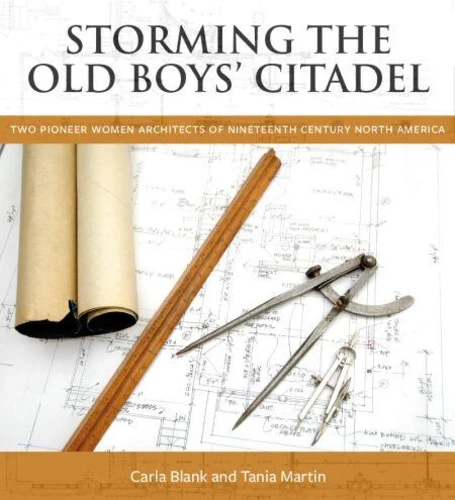Storming the Old Boys' Citadel. Two Pioneer Women Architects of Nineteenth Century North America
Par : ,Formats :
Disponible dans votre compte client Decitre ou Furet du Nord dès validation de votre commande. Le format ePub est :
- Compatible avec une lecture sur My Vivlio (smartphone, tablette, ordinateur)
- Compatible avec une lecture sur liseuses Vivlio
- Pour les liseuses autres que Vivlio, vous devez utiliser le logiciel Adobe Digital Edition. Non compatible avec la lecture sur les liseuses Kindle, Remarkable et Sony
 , qui est-ce ?
, qui est-ce ?Notre partenaire de plateforme de lecture numérique où vous retrouverez l'ensemble de vos ebooks gratuitement
Pour en savoir plus sur nos ebooks, consultez notre aide en ligne ici
- Nombre de pages234
- FormatePub
- ISBN978-1-77186-031-4
- EAN9781771860314
- Date de parution15/12/2014
- Protection num.Digital Watermarking
- Taille12 Mo
- Infos supplémentairesepub
- ÉditeurBaraka Books
Résumé
"Women" and "architecture" were once mutually exclusive terms. In an 1891 address, Louise Blanchard Bethune declared, "it is hardly safe to assert" that a connection even exists between the two words. Some women didn't agree.
Mother Joseph of the Sacred Heart (1823-1902) is credited with works built in the present states of Washington, Idaho, Montana, Oregon, and British Columbia. Born Esther Pariseau in Saint-Elzéar, Québec, the "Mother with a hammer" was honored by the State of Washington as one of two people to represent it in the National Statuary Hall Collection in Washington, D.
C. Louise Blanchard Bethune (1856-1913) designed and built works in the Buffalo, New York area, including the Lafayette Hotel, which was one of the eleven most luxurious hotels in the United States when it opened in 1904. Mother Joseph's and Louise Bethune's signature buildings, Providence Academy, Vancouver, Washington, and the Lafayette Hotel, Buffalo, New York, are both listed on the United States' National Register of Historic Places.
Both buildings are cases of historic preservation and adaptive reuse. Bridging disciplines from women's studies, architecture and architectural history to the fascinating past of the Pacific Northwest and Upstate New York, Storming the Old Boys' Citadel sheds new light on North America's common built environment and those who made it. In this book, based on years of research and keen story-telling skills, Carla Blank and Tania Martin also breathe new life into the lives and works of two remarkable nineteenth-century women.
C. Louise Blanchard Bethune (1856-1913) designed and built works in the Buffalo, New York area, including the Lafayette Hotel, which was one of the eleven most luxurious hotels in the United States when it opened in 1904. Mother Joseph's and Louise Bethune's signature buildings, Providence Academy, Vancouver, Washington, and the Lafayette Hotel, Buffalo, New York, are both listed on the United States' National Register of Historic Places.
Both buildings are cases of historic preservation and adaptive reuse. Bridging disciplines from women's studies, architecture and architectural history to the fascinating past of the Pacific Northwest and Upstate New York, Storming the Old Boys' Citadel sheds new light on North America's common built environment and those who made it. In this book, based on years of research and keen story-telling skills, Carla Blank and Tania Martin also breathe new life into the lives and works of two remarkable nineteenth-century women.
"Women" and "architecture" were once mutually exclusive terms. In an 1891 address, Louise Blanchard Bethune declared, "it is hardly safe to assert" that a connection even exists between the two words. Some women didn't agree.
Mother Joseph of the Sacred Heart (1823-1902) is credited with works built in the present states of Washington, Idaho, Montana, Oregon, and British Columbia. Born Esther Pariseau in Saint-Elzéar, Québec, the "Mother with a hammer" was honored by the State of Washington as one of two people to represent it in the National Statuary Hall Collection in Washington, D.
C. Louise Blanchard Bethune (1856-1913) designed and built works in the Buffalo, New York area, including the Lafayette Hotel, which was one of the eleven most luxurious hotels in the United States when it opened in 1904. Mother Joseph's and Louise Bethune's signature buildings, Providence Academy, Vancouver, Washington, and the Lafayette Hotel, Buffalo, New York, are both listed on the United States' National Register of Historic Places.
Both buildings are cases of historic preservation and adaptive reuse. Bridging disciplines from women's studies, architecture and architectural history to the fascinating past of the Pacific Northwest and Upstate New York, Storming the Old Boys' Citadel sheds new light on North America's common built environment and those who made it. In this book, based on years of research and keen story-telling skills, Carla Blank and Tania Martin also breathe new life into the lives and works of two remarkable nineteenth-century women.
C. Louise Blanchard Bethune (1856-1913) designed and built works in the Buffalo, New York area, including the Lafayette Hotel, which was one of the eleven most luxurious hotels in the United States when it opened in 1904. Mother Joseph's and Louise Bethune's signature buildings, Providence Academy, Vancouver, Washington, and the Lafayette Hotel, Buffalo, New York, are both listed on the United States' National Register of Historic Places.
Both buildings are cases of historic preservation and adaptive reuse. Bridging disciplines from women's studies, architecture and architectural history to the fascinating past of the Pacific Northwest and Upstate New York, Storming the Old Boys' Citadel sheds new light on North America's common built environment and those who made it. In this book, based on years of research and keen story-telling skills, Carla Blank and Tania Martin also breathe new life into the lives and works of two remarkable nineteenth-century women.





